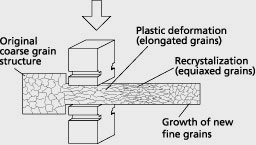When buyers must select a process and supplier for the production of an important metal part, they face an enormous array of possible alternatives. A great many metalworking processes are now available, each offering a unique set of capabilities, costs and advantages. The forging process is ideally suited to many part applications, however some buyers may be unaware of the exclusive benefits available only from this ancient form of metal forming. In fact, forging is often the optimum process, in terms of both part quality and cost-efficiency-especially for applications that require maximum part strength, special sizes or critical performance specifications.
There are several forging processes available, including impression or closed die, cold forging, and extrusion. However, here we will discuss in detail the methods, application and comparative benefits of the open die and seamless rolled ring forging processes. We invite you to consider this information when selecting the optimum process for the production of your metal parts.
A Historical Perspective
Perhaps the oldest mechanical method of metalworking known to man, forging traces its origins from ancient Egypt through the blacksmith shops of the pre-industrial period, and directly to the high-technology forging plants of today.
To meet the changing needs of industry, forging has evolved to incorporate the tremendous advances in equipment, computers and electronic controls that have occurred in recent years. These sophisticated tools complement the creative human skills which, even today, are essential to the success of every forging made. Modern forging plants are capable of producing superior quality metal parts in a virtually limitless array of sizes, shapes, materials and finishes.
Forging Defined

How the open die forging process affects
the crystal structure.
At its most basic level, forging is the process of forming and shaping metals through the use of hammering, pressing or rolling. The process begins with starting stock, usually a cast ingot (or a "cogged" billet which has already been forged from a cast ingot), which is heated to its plastic deformation temperature, then upset or "kneaded" between dies to the desired shape and size.
During this hot forging process, the cast, coarse grain structure is broken up and replaced by finer grains. Low-density areas, micro-shrinkage and gas porosity inherent in the cast metal are consolidated through the reduction of the ingot, achieving sound centers and structural integrity. Mechanical properties are therefore improved through the elimination of the cast structure, enhanced density, and improved homogeneity. Forging also provides means for aligning the grain flow to best obtain desired directional strengths. Secondary processing, such as heat treating, can also be used to further refine the part.
No other metalworking process can equal forging in its ability to develop the optimum combination of properties.
